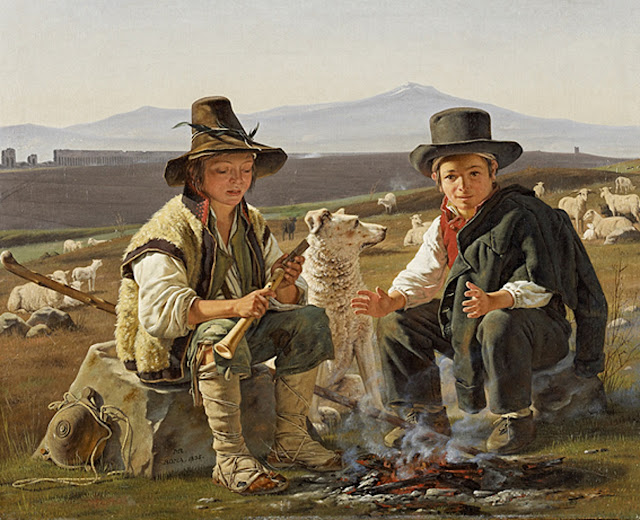 |
| Thomas Cole Expulsion from the Garden of Eden 1828 oil on canvas Museum of Fine Arts, Boston |
 |
| Joseph Mallord William Turner Snow Storm - Hannibal and his Army crossing the Alps 1812 oil on canvas Tate Gallery |
 |
| Joseph Mallord William Turner Fall of the Rhine at Schaffhausen ca. 1805-1806 oil on canvas Museum of Fine Arts, Boston |
 |
| John Constable Hampstead Heath ca. 1820 oil on canvas Fitzwilliam Museum, Cambridge |
'The story goes that a friend remonstrated with him for not giving his foreground the requisite mellow brown of an old violin, and that Constable thereupon took a violin and put it before him on the grass to show the friend the difference between the fresh green as we see it and the warm tones demanded by convention.' It was an amusing gesture, but obviously we must not infer that Sir George had never noticed that grass was green and violins brown, or that Constable made that momentous discovery. Both of them knew, of course, that such matching will never do. The point at issue was a much more subtle one – how to reconcile what we call 'local colour' with the range of tonal gradations which the landscape painter needs to suggest depth."
"We find an echo of these discussions in an observation by Benjamin West recorded in the Farington Diary: 'He thinks Claude began his pictures by laying in simple gradations of flat colours from the Horizon up to the top of the sky, – and from the Horizon to the foreground, without putting clouds into the sky or specific forms into the landscape till He had fully settled those gradations. – When he had satisfied himself in this respect, He painted in his forms, by that means securing a due gradation, – from the Horizontal line to the top of his sky, – and from the Horizontal line to the foreground. – Smirke remarked how entirely all positive colour was avoided, even to the draperies of the figures. – Turner said He was both pleased and unhappy while He viewed it, – it seemed to be beyond the power of imitation'.
"These experiments with gradation from a pale blue to a mellow brown by seventeenth- and eighteenth-century artists taught Sir George Beaumont how to suggest light and distance in a landscape. . . . It is a transposition, not a copy. . . . Once we realize this basic fact, the master's contention that all paintings should be viewed as experiments in natural science loses much of its puzzling character. He is trying to produce what he called the 'evanescent effects of nature's chiaroscuro' on canvas, within a medium which excludes matching. Indeed his experiments resulted in discoveries. For instance, there was a resistance at first against so much green, which was thought to upset the needed tonal gradation. There is a pathetic story about Constable's sitting on the jury of the Royal Academy, of which he was a member, when by mistake one of his own paintings was put on the easel for judgment, and one of his colleagues said rashly, 'Take that nasty green thing away'. But we also know that when his Hay Wain was shown in Paris, French artists were stimulated to repeat his experiments and lighten their palettes. We need only walk through any major gallery to see that in the end Constable's method found acceptance. Green is no longer considered 'nasty'."
– E.H. Gombrich, from Art and Illusion: a Study of the Psychology of Pictorial Representation, originally delivered as the A.W. Mellon Lectures in the Fine Arts, 1956
 |
| John Constable Malvern Hall, Warwickshire 1809 oil on canvas Tate Gallery |
 |
| John Gadsby Chapman Pines of the Villa Barberini (outside Rome) 1856 oil on canvas Museum of Fine Arts, Boston |
 |
| George Inness Villa Borghese, Rome ca. 1857 oil on canvas mounted on board Museum of Fine Arts, Boston |
 |
| Erastus Salisbury Field The Garden of Eden ca. 1860 oil on canvas Museum of Fine Arts, Boston |
 |
| George Hayter After the Storm 1833 oil on canvas Walters Art Museum, Baltimore |
 |
| Heneage Finch Landscape with Shepherd before 1812 watercolor British Museum |
 |
| Samuel Palmer Italian Hill Town ca. 1838 watercolor, gouache Yale Center for British Art |
 |
| Samuel Palmer The Colosseum of Rome (preparatory illustration for Pictures from Italy by Charles Dickens) ca. 1846 drawing Morgan Library, New York |
 |
| Edward Rippingille Mendicants of the Roman Campagna 1840 oil on canvas Victoria & Albert Museum |
 |
| Martinus Rørbye Two Shepherd Boys in the Roman Campagna 1833 oil on canvas National Galleries of Scotland |